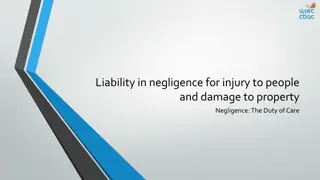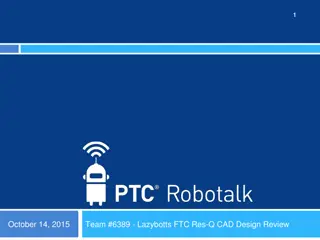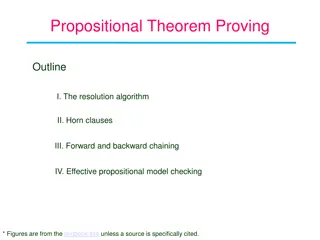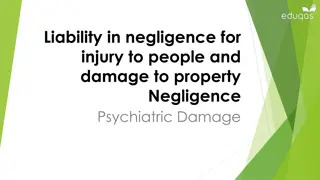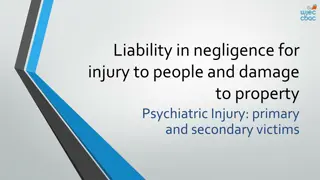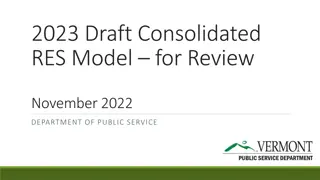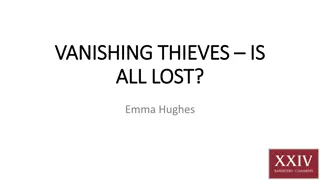Understanding Res Ipsa Loquitur in Proving Negligence
Res Ipsa Loquitur is a legal principle where the occurrence of an accident implies negligence on the part of the defendant. It shifts the burden of proof to the defendant, requiring them to explain the incident's cause. Originating from the Scott v London case in 1865, this principle has been applied in various legal cases to establish negligence when it is challenging to determine the exact actions or omissions leading to the harm. The rule provides a common-sense approach to inferring negligence based on available evidence.
Download Presentation

Please find below an Image/Link to download the presentation.
The content on the website is provided AS IS for your information and personal use only. It may not be sold, licensed, or shared on other websites without obtaining consent from the author. Download presentation by click this link. If you encounter any issues during the download, it is possible that the publisher has removed the file from their server.
E N D
Presentation Transcript
RES IPSA LOQUITUR (EVIDENTIAL RULE IN PROVING NEGLIGENCE) Dr. Sonny Zulhuda LAW 1510
Outline Definition of the Maxim Origins & Rationale Effect: Inference of Breach Elements to Establish the Maxim Case studies
Res Ipsa Loquitur Literally means: The thing speaks for itself The thing = the fact(s) It is a not a rule/principle of substantive law, but rather a rule of evidence affecting the onus of proof premised on common sense, fair play and justice. per Harmindar Singh JC, in David Chelliah v Monorail Malaysia [2009] To be raised by Plaintiff in negligence and nuisance cases.
Origins of the Rule Scott v London and St Katherine Docks Co (1865) 3 H&C 596 P (a customs officer) was injured by some sugar bags falling on him in the defendant's warehouse. Erle CJ: There must be some reasonable evidence of negligence. But where the thing is shown to be: under the management of the defendant or his servants, and the accident is such as in the ordinary course of things does not happen if those who have the management use proper care, it affords reasonable evidence, in the absence of explanation by the defendants, that the accident arose from want of care. sugar
Rationale of the Rule David Chelliah v Monorail Malaysia [2009] 4 MLJ 253 The basic rule that it is for the plaintiff to prove negligence and not for the defendant to disprove it, may cause hardship to the plaintiff if it is impossible for him to know what precise acts or omission led to this damage and this is most obviously so where the cause of the damage is peculiarly within the means of knowledge of the defendant who caused it. Also cited in MA Clyde v Wong Au Mei [1970] 2 MLJ 183
Effects of the Rule Lloyd v West Midlands Gas Board [1971] 2 All ER 1240 Megaw LJ described the rule as a common sense approach to the effect of the evidence in certain circumstances. It means that a plaintiff prima facie establishes negligence where: 1. it is not possible for him to prove precisely what was the relevant act or omission which set in the events leading to the accident, but 2. on the evidence as it stands at the relevant time it is more likely than not that the effective cause of the accident was some act or omission of the defendant or of someone for whom the defendant was responsible, which act or omission constitutes a failure to take proper care for the plaintiff's safety. Cited by Malaysian courts in: Teoh Guat Looi v Ng Hong Guan [1998] 4 AMR 3815; and David Chelliah v Monorail Malaysia [2009] 4 MLJ 253.
3 Elements under RIL The thing was under the control of the D Lembaga Kemajuan Tanah Persekutuan v Mariam [1984] 1 MLJ 283 In the ordinary course of business, it does not usually happen unless with negligence Pacific Tin Consolidated Corp v Hoon Wee Thim Absence (or lack) of explanation from Defendant David Chelliah vs Monorail Malaysia Technology Sdn Bhd [2009] 4 MLJ 253
Lembaga Kemajuan Tanah Persekutuan v Mariam [1984] 1 MLJ 283 The appellants (Felda) engaged a contractor to weed and maintain a land scheme in Pahang. Unknown to them, the contractor sub-contracted the work. The workers of the sub-contractor lived in a Kongsi-house built by either the contractor or the sub-contractor on the land scheme. The house collapsed, causing death of an employee of the sub-contractor. The deceased s dependants sued the contractor, sub-contractor and Felda. Felda denied liability, contending that since they owed no duty of care since there was no contractual liability.
Lembaga Kemajuan Tanah Persekutuan v Mariam [1984] 1 MLJ 283 Salleh Abbas: Can Felda now turn around and say it was not liable to the injured occupant because it did not build the kongsi-house? In our view, it cannot. Although Felda did not build it, it allowed to be erected and used by the weeding labourers, whose work benefited Felda, and although it had control and supervision of the scheme and well-being of the labourers, Felda did nothing to ensure that the kongsi-house was safe for them to live in. It only allowed it to exist and be used. In our view, this is not enough. It most go further and see that they are complied with. Court held that the Kongsi-house for unknown reason collapsed, and no proper explanation was forthcoming from Felda. Therefore, RIL was applied in that the kongsi-house was unsafe and Felda was found liable.
Pacific Tin Consolidated Corp v Hoon Wee Thim App maintained on their lands large ponds for tin dredge-mining operations. They separated each ponds with bunds (embankment street). The ponds were above ground level. Water flow from one pond to another by means of spillways. The land was located in an inclined valley. A large breach in the bund between two large ponds, which together held nearly 500mil gallons of water, caused a violent outflow to the lower lands. This caused extensive damage to life and property to the adjacent lands. Plaintiff (Respondent) sued App for the damage.
Pacific Tin Consolidated Corp v Hoon Wee Thim Federal Court held the appellant liable in negligence. Ong Hock Thye: The maxim RIL applied. It seem self evident that, when one portion gave away, while another stood up to a strain that affected the whole bund equally, they were not equally stable, unless the collapse could be traced to some external cause operating on one but not the other.
David Chelliah @ Kovilpillai Chelliah David v Monorail Malaysia Technology Sdn Bhd & Ors [2009] 4 MLJ 253
David Chelliah v Monorail Malaysia Technology Sdn Bhd & Ors [2009] Prior to the opening of the KL Monorail, on 16 August 2002, an accident occurred during a test run involving a 13.4 kg safety wheel falling off a train and hitting the head of a pedestrian walking under the monorail overpass at Jalan Sultan Ismail. The victim, Mr David Cheliah, a journalist, suffered injuries that required hospitalisation. He filed a RM5million negligence suit against the monorail companies involved in the design, installation and operation of the trains, as well as the Director-General of Railways.
David Chelliah v Monorail Malaysia Technology Sdn Bhd & Ors [2009] BURDEN OF PROOF? In any action for negligence, the burden is on the plaintiff to prove certain specific acts or omissions on the part of the defendant to show some negligent conduct. Sometimes a prima facie inference of negligence may be drawn from the circumstances of the case by recourse to the maxim known as res ipsa loquitur. Loosely translated, this Latin phrase means 'the event speaks for itself'. It is essentially a rule of evidence premised on common sense, fair play and justice.
David Chelliah v Monorail Malaysia Technology Sdn Bhd & Ors [2009] BASED ON THE FACTS OF THE CASE: A safety wheel of a monorail train does not, in the ordinary course of things, fall off and hit persons on the ground below. It will also be fair to say that the safety wheel on the train was under the sole control of the defendants or their servants. Although P could point to the safety wheel coming off the monorail train, he is unable to state precisely why the wheel had come off therefore clear to me that the plaintiff had made out a prima facie case of negligence on the part of the first and second defendants. It was therefore incumbent on the part of the first and second defendants to provide credible evidence to show that the incident occurred without negligence.
David Chelliah v Monorail Malaysia Technology Sdn Bhd & Ors [2009] R.I.L Inference of Negligence (What should Defendant do?) An inference of negligence can be rebutted by introducing evidence. Although the burden of proof remains throughout on the plaintiff, where a prima facie case of negligence has been made out, the defendant bears the burden of introducing evidence to explain and show how the incident occurred without negligence on his or her part. Failure to do so will establish liability on the part of the defendants
David Chelliah v Monorail Malaysia Technology Sdn Bhd & Ors [2009] it was held in Moore v R Fox & Sons [1956] 1 QB 596 that the onus of proof is not discharged by merely showing that the accident was inexplicable. To discharge the onus they had to go further and either show that they had not been negligent, or give an explanation of the cause of the accident which did not connote negligence by them.
David Chelliah v Monorail Malaysia Technology Sdn Bhd & Ors [2009] In the present case, defendants had failed to provide a reasonable explanation as to how the safety wheel had come off the train. They only alluded to a possibility that there had been tampering by unknown persons. However, no evidence of tampering was disclosed (and) significantly, it could not have been the only possible cause. It might also have been the case that the bolts were not sufficiently tightened by the employees of the defendants In my view, the first and second defendants have fallen far short of discharging the onus. 1st and 2nd defendants were found liable.
New cases Shalini a/p Kanagaratnam v Pusat Perubatan Universiti Malaya (formerly known as University Hospital) & Anor [2016] 3 MLJ 742 Sabah Shell Petroleum Co Ltd & Anor v The Owners of and/or Any Other Persons Interested in the Ship or Vessel the ' Borcos Takdir' [2012] 5 MLJ 515 Malie bin Jolhi (suing as administrator of the estate of Rumi Azzan bin Malie, deceased and for and on behalf of the dependents of the deceased) v Pengarah Jabatan Alam Sekitar (Negeri Sarawak) Kementerian Sains, Teknologi dan Alam Sekitar & Ors [2011] 3 MLJ 250 RIL was not sufficiently established, therefore rejected by the Court


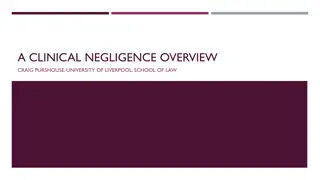
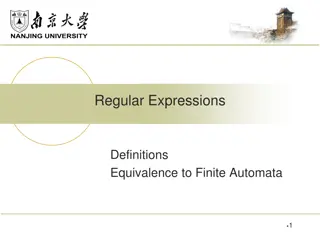
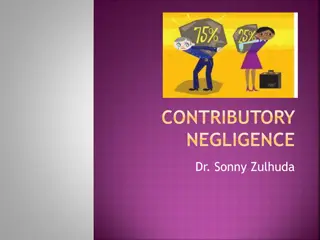
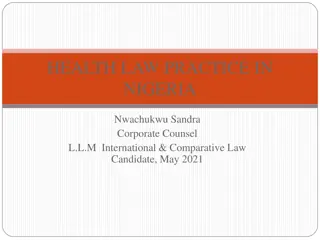
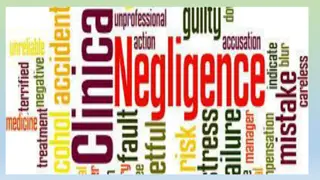

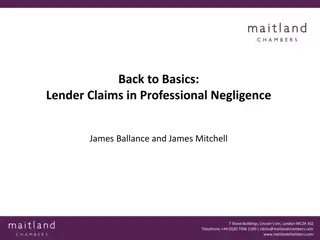

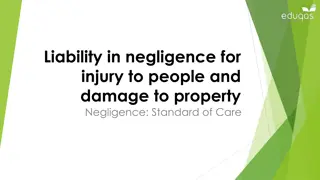

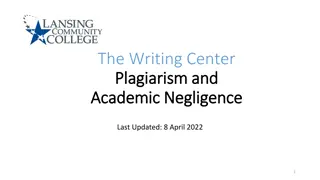

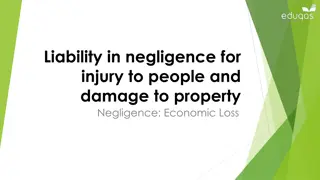
![Understanding Negligence Liability in Donoghue v. Stevenson [1932]](/thumb/198881/understanding-negligence-liability-in-donoghue-v-stevenson-1932.jpg)
